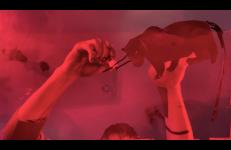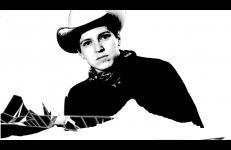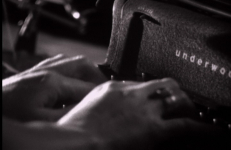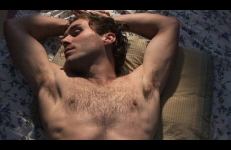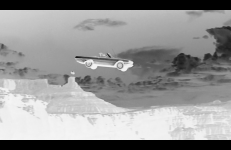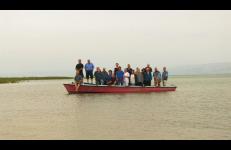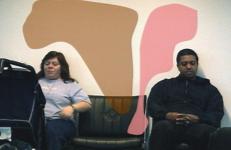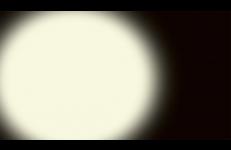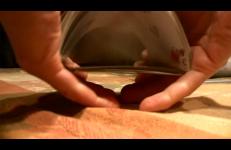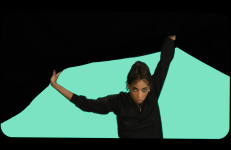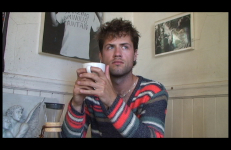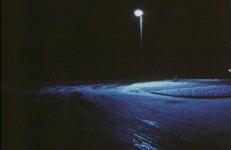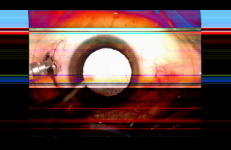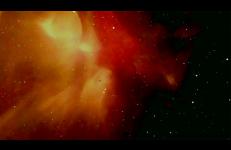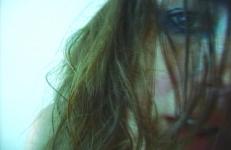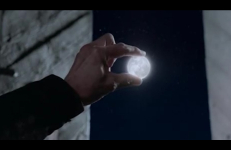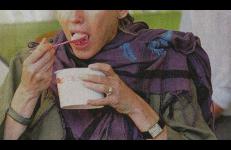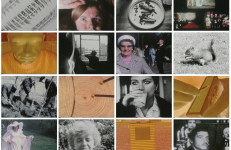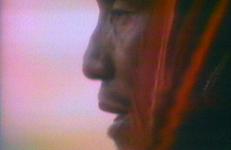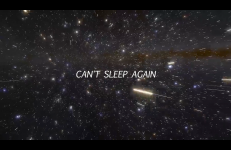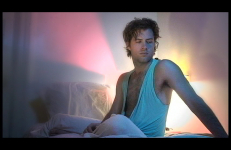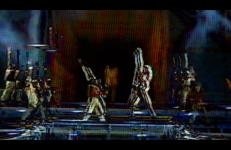Future From Inside is the last in the trilogy begun in 2016, by Dani and Sheilah ReStack (also including Strangely Ordinary this Devotion and Come Coyote.) The work traces the ReStack collaboration, as it manifests in life and in work.
Mental Landscape
"i am very grateful that my 鬼鎮 (Ghosttown) series has shown internationally over the last couple years and is recognized by viewers, reviewers, critics, and curators as doing decolonizing work as a feminist project that queers and glitches the Western genre. 鬼鎮 (Ghosttown) questions the quintessentially American Western in the forms of experimental films and games that are made from glitches and noise, pushing boundaries of legibility and tipping over threshold states of stability.
This fictional memoir gives voice to the woman who haunted Andre Breton's 1927 Surrealist novel Nadja. Speaking from the sanitarium as World War II approaches, she recounts their nine-day love affair in the streets of Paris. Nadja is imaged following the game of exquisite corpse, with staged and framed gestures, excerpts from Surrealist films and archival newsreels as well as fragments from the walks of the filmmaker as flaneur.
Flesh and blood souls breathe forth the colors of doubt, guilt and a hope for "peace of mind" in a world without moral directions... This video is about strength and weakness, done with human forms assembled and lovingly digitized.
This title comprises The Poet's Battle (2016), NightSchool (2015), Ascension (2013), Lost Blues (2014), and A Rented Space (2015) which were compiled into this form by Mike Kuchar in 2022.
Goodbye Thelma synthesizes footage from the 1991 film Thelma & Louise with footage of the author’s own making to create a mysterious, and at times disturbing, exploration of traveling alone. In contrast to the dramatic events of Thelma & Louise, this story is one of suspended fear, which inverts stunning vistas into unsettling and uncertain landscapes.
A collection of unidentified individuals is stuck together on a boat. Are they going home? Where is their home and why are they so silent? This short work takes a look at a displaced and uprooted community.
Shot in Portland International Airport. Animation by Jalal Jemison.
"In Haysha Royko, three people sit nonchalantly in airport chairs, while their different-colored auras, or something much like auras, shape shift, overlap, and compete."
— Emily Hall, The Stranger, July 17th, 2003
The video hovers tentatively between therapy, documentary, poetics and mystic traipsery and ends, like all good things, in surrender to song. There is a challenge presented (the challenge to engage earnestly with the piece as it requests) to fall into the breathing and pacing presented, and the challenge to view the video as a discrete piece of art at the same time. The piece relies heavily on the text, the disembodied Virgil through which the words become musical, instructive and (due to the absence of image) visual.
"By way of lush formal and associative shifts, Hearts Are Trump Again evokes the ever-present tension between seemingly polarized states of experience. Desire and repulsion; freedom and constraint; pain and pleasure all find articulation in images of ferocious dogs and mock conversations about childbearing. Tonally complex and viscerally rich, Hearts Are Trump Again is a lyrical exploration of emotional weather."
— Brett Price
Home Movies Gaza introduces us to the Gaza Strip as a mircrocosm for the failure of civilization. In an attempt to describe the everyday of a place that struggles for the most basic of human rights, this video claims a perspective from within the domestic spaces of a territory that is complicated, derelict, and altogether impossible to separate from its political identity.
"... Basma Alsharif’s Home Movies Gaza, a film that captures the impossibly politicized domestic sphere of the Gaza Strip, under the constant hum and buzz of overhead drones."
A poem or brief poetic collage of 16mm home movie footage from Egypt in the 1950s along with elements of Capra's Lost Horizon soundtrack interwoven with recordings of a small and frustrated boy.
The original footage was given to me by my mother, who worked some 30 years as a maid for the millionaire couple who shot this while on an around-the-world honeymoon trip. The woman’s voice pondering utopia, peace and joy; the small boy frustrated by the tonal and linguistic romanticism of this expression.
Adapted from psychologist A.R. Luria’s research in the Islamic outskirts of the Soviet Union in the 1930s, How to Fix the World brings to life Luria's conversations with Central Asian farmers learning how to read and write under the unfamiliar principles of Socialism.
Colorful digital animations based on Max Penson's photographs of collective farmers play against a backdrop of landscape images shot in Uzbekistan in 2004.
In i am wise enough to die things go (2023), Syms explores the idea of psychosis through an unnamed protagonist reciting a monologue. Responding to the work of iconic animator Chuck Jones, Syms transfers the form and narrative structure of an animated short into live-action. Working with the inherent challenges and restrictions brought about by this sort of translation, she delves into both the breaking up of images and the breakdown of the psyche.
Do walls have ‘tales’ to tell? Are ghosts the only ’friend’ one has on sleepless nights when the mind whispers to the soul and a beating heart drums its deeply felt message out into the darkness?
- See what the drum discovers, and you will know why.
An uncompromising look at the ways privacy, safety, convenience and surveillance determine our environment. Shot entirely at night, the film confronts the hermetic nature of white-collar communities, dissecting the fear behind contemporary suburban design. An isolation-based fear (protect us from people not like us). A fear of irregularity (eat at McDonalds, you know what to expect). A fear of thought (turn on the television). A fear of self (don’t stop moving).
This is the state of mind in the post-Covid quarantine. This is the state of the body into the pandemic vortex. This is our post-Covid eyes. Part of the Hauntology and Post-Covid series.
A deceased hoarder, reconstituted through technology, recounts a difficult childhood as inhabitants of a virtual world struggle to reconcile materialistic tendencies. A scientist leads an effort to understand the passage of time, but the data is unreliable. The question remains, what happens to our things after we are gone?
The repeatedly distorted, primate behaviour of an (ani)female carrying her baby, reflecting the pain and suffering provoked by the mother/child relationship.
What I am//What you are//salt and sweat on my tongue.
A quarantined love letter of domestic imagination. A year of rain and other fluids. Contentment is a difficult emotion. 26 Main St. Bucksport, ME
A familiar landscape comprised of big box stores and parking lots proves a rich site for longing, intimacy, and radical change. Celebrities are observed in this environment and are reduced to ordinary beings in the process. An enigmatic protagonist reveals little moments of subjectivity that escape into the piece like a contaminant, rupturing the view and evidencing the paradox of connection and belonging within systems that simultaneously contain us and comprise us.
There were three brides, and they all married at different times to different people in different places. They came from similar backgrounds and lived in the same general area, but circumstances had led them down parallel - never to cross - paths. One night, however, they all shared the same dreams…
The personal odyssey recorded in The Laughing Alligator combines methods of anthropological research with diaristic essay, mixing objective and subjective vision. Recorded while Downey and his family were living among the Yanomami people of Venezuela, this compelling series of anecdotes tracks his search for an indegenous cultural identity.
Life Without Dreams is set in the outer space of consciousness, where the surfaces of far out planetary bodies form the terrain for an exploration of 24/7 capitalism, insomnia, and the disappearance of darkness.
Take a trip into and out of the body to ponder Time’s endless depths where Earth spirits roam and inner Demons lurk, and find secrets that hide behind the "self". Its here for you to see.
This title comprises Moon Lit Vows (2017), Boy in the Mirror (2015), Celestial Horizons (2019), Book of the Angel (2017) and Floating on the Currents of Consciousness (2019) which were compiled into this form by Mike Kuchar in 2022.
In the film Mad Ladders, the prophetic ramblings of an unseen narrator recount fantastical dreams of the coming Rapture, as crystalline imagery of rolling clouds gives way to heavily-processed video of moving stage sets from The American Music Awards telecasts of the 1980s and early 1990s. Blooming and pulsing in and out of geometric abstraction, this swirling storm of rising curtains, spinning set pieces, and unveiled pop idols forms an occult spectacle, driven by its impassioned narrator and an 8-bit leitmotif.




